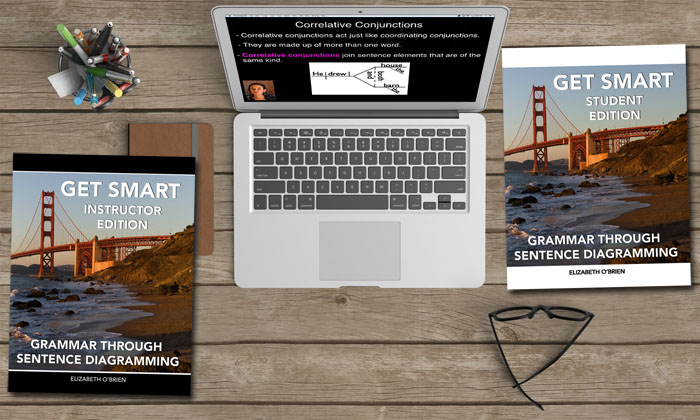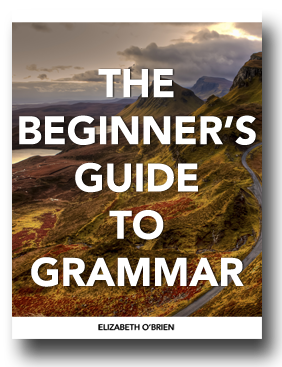📘 Download your free grammar guide here. 📘
📘 Download your free grammar guide here. 📘
Diagramming Direct Speech
Diagramming Direct Speech
- Home
- Clauses
- Noun Clauses
- Direct Speech
Today, I'm answering a reader's question about diagramming sentences that include direct quotations.
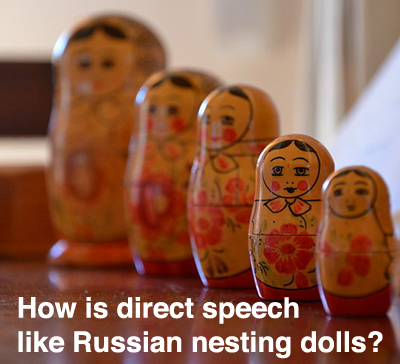
Elizabeth,
Thank you for your grammar lessons. I have a diagramming question for you. How do I diagram sentences with direct speech when the direct speech itself is a complete sentence? Thank you for your help.
- Robyn
Here are two examples of what Robyn is asking about.
1. Bob yelled, "We won!"
2. Maria said, "I feel sleepy."
Did you notice that in both of our example sentences, the quoted speech is a complete sentence? It's almost as if we have a sentence within a sentence! It reminds me of those Russian nesting dolls that fit inside of each other (Matryoshka dolls).
Before we cover how to diagram our example sentences, we need to have a review of some relevant information, so let's review basic diagramming, direct objects and noun clauses! Wahoo!
Basic Sentence Diagramming
Sentence diagrams are pictures of sentences that help us see the grammatical relationship between the elements in a sentence. Let's look at a very basic sentence diagram.
Here's how we diagram a subject and verb.
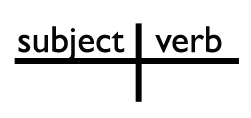
Notice that the lines make kind of a cross design. Since all sentences have at least a subject and a verb, you'll always see this cross-looking thing in every sentence diagram. When you see it, know that the subject is on the left side of the cross and the verb on the right side of the cross.
Direct Objects
Direct objects are nouns that receive the action of certain kinds of action verbs. We can find direct objects by asking What did (subject) (verb)?
Karen kicked the ball.
James wrote a paper.
What did Karen kick? She kicked the ball. Ball is a direct object. It is a noun receiving the action of the verb kicked.
What did James write? He wrote a paper. Paper is a direct object. It is a noun receiving the action of the verb wrote.
When diagramming a sentence that has a direct object, you need to extend the sentence's horizontal line to the right. Then, place a short vertical line just after the verb and write your direct object in that slot.

Noun Clauses
Clauses are groups of words that contain a subject and a verb. Noun clauses are clauses that perform the job of a noun.
Whatever you want is fine with me.
Can you tell me what we are having for dinner?
Whatever you want is a noun clause. It contains a subject (you) and a verb (want), and the whole clause is performing the job of a noun. It's the subject of the sentence.
What we are having for dinner is a noun clause. It contains a subject (we) and a verb (are having), and the whole clause is performing the job of a noun. It's the direct object of the verb tell.
When we diagram our noun clauses, we think about what noun job the clause is performing. For example, let's look at a diagram with a noun clause that's acting as the direct object.
Think of the direct object slot in the sentence diagram. Can you remember where that is? Great! That's where we'll add our noun clause.
Since noun clauses contain a subject and a verb, it—along with the main clause in the sentence—will have that cross structure. We find the cross that belongs to the noun clause and plop it into the direct object space in our diagram.
This is where the Russian nesting doll concept comes into play. Check it out!

Back to Our Direct Speech Example Sentences
1. Bob yelled, "We won!"
2. Maria said, "I feel sleepy."
In both of our example sentences, the words within the quotation marks are noun clauses. They contain a subject (we and I) and a verb (won and feel), and they are both performing the job of a noun.
Both of those noun clauses are acting as direct objects.
We won is the direct object of the verb yelled. What did Bob yell? He yelled We won.
1. Bob yelled, "We won!"
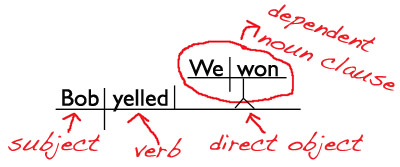
I feel sleepy is the direct object of the verb said. What did Maria say? She said I feel sleepy.
2. Maria said, "I feel sleepy."
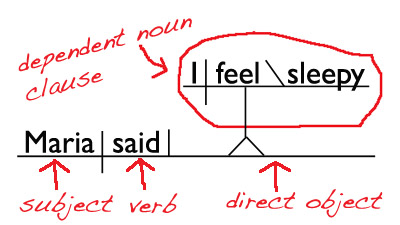
If you'd like to teach or learn grammar the easy way—with sentence diagrams—check out our Get Smart Grammar Program.
It starts from the very beginning and teaches you grammar and sentence diagramming in easy, bite-size lessons.

Hello! I'm Elizabeth O'Brien, and my goal is to get you jazzed about grammar.
My students love diagramming and are learning so much. Thank you for your inspiration and instruction.
- Destiny, Teacher
This is original content from https://www.english-grammar-revolution.com/direct-speech.html
Our Free Guide Gives You A Fun Way
To Teach And Learn The Basics v

Elizabeth O'Brien is the creator of Grammar Revolution.
Her lessons are guaranteed to give you more confidence in your communication skills and make you smile. :)
